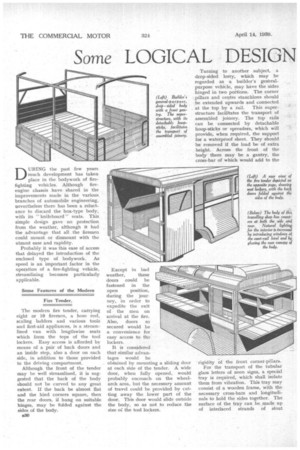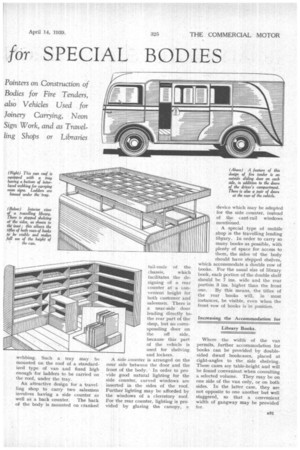Some LOGICAL DESIGN for SPECIAL BODIES Pointers on Construction of
Page 40

Page 41

If you've noticed an error in this article please click here to report it so we can fix it.
Bodies for Fire Tenders, also Vehicles Used for Joinery Carrying, Neon Sign Work, and as Travelling Shops or Libraries DLTRING the past few years much development has taken place in the bodywork of firefighting vehicles. Although fireengine chassis have shared in the improvements made in the various branches of automobile engineering, nevertheless there has been a reluctance to discard the box-type body, with its " knifeboard " seats. This simple design gave no protection from the weather, although it had the advantage that all the firemen could mount or dismount with the utmost ease and rapidity.
Probably it was this ease of access that delayed the introduction of the enclosed type of bodywork. As speed is an important factor in the operation of a fire-fighting vehicle, streamlining becomes particularly applicable.
The modern fire tender, carrying eight or 10 firemen, a hose reel, scaling ladders and various tools and first-aid appliances, is a streamlined van with lengthwise seats which form the tops of the tool lockers. Easy access is afforded by means of a pair of back doors and an inside step, also a door on each side, in addition to those provided to the driving compartment.
Although the front of the tender may be well streamlined, it is suggested that the back of the body should not be curved to any great extent. If the back be almost flat and the hind corners square, then the rear doors, if hung on suitable hinges, may be folded against the sides of the body.
930 Except in bad weather, these doors could be fastened in the open position, during the journey, in order to expedite the exit of the men on arrival at the fire. Also, doors so secured would be a convenience for easy access to the lockers.
It is considered that similar advantages would be obtained by mounting a sliding door at each side of the tender. A wide door, when fully opened, would probably encroach on the wheelarch area, but the necessary amount of travel could be provided by cutting away the lower part of the door, This door would slide outside the body, so as not to reduce the size oi the tool lockers. Turning to another subject, a drop-sided lorry, which may be regarded as a builder's gerferalpurpose vehicle, may have the sides hinged in two portions. The corner . pillars and centre stanchions should be extended upwards and connected at the top by a rail. This superstructure facilitates the transport of assembled joinery. The top rails can be connected by detachable hoop-sticks or spreaders, which will provide, when required, the support for a waterproof sheet. They should be removed if the load be of extra height. Across the front of the body there may be a gantry, the cross-bar of which would add to the
rigidity Of the front corner-pillars. For the transport of the tubular glass letters of neon signs, a special tray is required, which shall isolate them from vibration. This tray may consist of a wooden frame, with the necessary cross-bars and longitudinals to hold the sides together. The surface of the tray can be made up of interlaced strands of stout webbing. Such a tray may be mounted on the roof of a standardized type of van and fixed high enough for ladders to be carried on the roof, under the tray.
An attractive design for a travelling shop to carry two salesmen involves having a side counter is well as a back counter. The back of the body is mounted on cranked tail-ends of the
chassis, which facilitates the designing of a rear counter at a convenient height for both customer and salesmen. There is a near-side door leading directly to-, the rear part of the shop, but no corresponding door on
the off side, because this part of the vehicle is used for shelving and lockers.
A side .counter is arranged on the near side between the door and the front of the body. • In order to provide good natural lighting for the side counter, curved windows are inserted in the sides of the roof. Further lighting may be afforded by the windows of a clerestory roof. For the rear counter, lighting is provided by glazing the canopy, a device which may be adopted for the side counter, instead of the cant-rail windows mentioned.
A special type of mobile shop is the travelling lending library. In order to carry so many books as. possible, with plenty of space for access to them, the sides of the body should have stepped shelves, which accommodate a double row of books. For the usual size of library book, each portion of the double shelf should be 7 ins, wide and the rear portion 3 ins, higher than the front one. By this means, the titles of the rear books will, in most instances, be visible, even when the front row of books is in position.
Where the width of the van permits, further accommodation for books can be provided by doublesided dwarf bookcases, placed at right-angles to the side shelving. These cases arc table-height and will be found convenient when consulting a selected volume. They may be on one side of the van only, or on both sides. In the latter case, they are not opposite to one another but well staggered, so that a convenient width of gangway may be provided for.




















































































